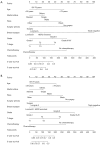Nomogram for predicting survival in breast cancer with lung metastasis based on SEER data
- PMID: 40104706
- PMCID: PMC11912048
- DOI: 10.21037/tcr-24-1047
Nomogram for predicting survival in breast cancer with lung metastasis based on SEER data
Abstract
Background: The incidence of breast cancer (BC) has been steadily increasing, highlighting the need for a predictive model to assess the survival prognosis of BC patients. The objective of this research was to formulate a prognostic nomogram framework tailored to forecast survival among individuals diagnosed with BC with lung metastasis (BCLM).
Methods: Our information was sourced from the Surveillance, Epidemiology, and End Results (SEER) database. Individuals who were diagnosed with BC from 2010 to 2015 were selected. The 4,309 collected participants were randomly separated into a training cohort (n=3,231) and a validation cohort (n=1,078). In this study, age, marital status, race, tumor location, laterality, type of primary surgery, surgical margin, tumor grade, tumor (T) stage, node (N) stage, as well as the use of radiotherapy and chemotherapy, were identified as potential prognostic factors. The overall survival (OS) and breast cancer-specific survival (CSS) were defined as the primary endpoints of this study. Univariate and multivariate analyses were conducted to assess the impact of different factors on prognosis. Structured nomograms were developed to improve the prediction of OS and CSS. The concordance index (C-index), receiver operating characteristic (ROC) curves, calibration curves, and decision curve analysis (DCA) were employed to estimate the performance of the nomogram.
Results: The nomograms incorporated age, marital status, race, primary surgery or not, BC subtype, grade, T stage, and the use of chemotherapy or not. The C-index for OS was 0.77, and it was 0.77 in CSS for the training group. The C-indexes for the control group of OS and CSS prediction were 0.78 and 0.78, respectively. ROC curves, calibration plots, and DCA curves displayed excellent predictive validity. The results indicate a median survival time of 1.67 years [95% confidence interval (CI): 1.58-1.83], with a total of 3,640 deaths recorded. Survival time was found to be associated with factors such as age, marital status, race, whether primary site surgery was performed, BC subtype, tumor grade, T stage, and the administration of chemotherapy.
Conclusions: Nomograms were created to predict OS and CSS for individuals diagnosed with BCLM. The nomogram has a reliable and valid prediction power; it could perhaps assist physicians in calculating patients' mortality risk.
Keywords: Nomograms; Surveillance, Epidemiology, and End Results program (SEER program); breast neoplasms; lung metastasis; prognosis.
Copyright © 2025 AME Publishing Company. All rights reserved.
Conflict of interest statement
Conflicts of Interest: All authors have completed the ICMJE uniform disclosure form (available at https://tcr.amegroups.com/article/view/10.21037/tcr-24-1047/coif). All authors report that this study was supported by the Wenzhou Medical and Health Scientific Research Project (project plan No. 2022012). The authors have no other conflicts of interest to declare.
Figures








References
-
- Kimura D, Kaneta A, Muto C, et al. Solitary mediastinal metastasis from breast cancer after 14 years: case report. Shanghai Chest 2024;8:19. 10.21037/shc-24-9 - DOI
LinkOut - more resources
Full Text Sources
